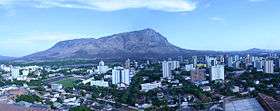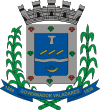Governador Valadares, Minas Gerais
Governador Valadares is a Brazilian municipality in the countryside of Minas Gerais. In 2018, its population was 278,685 inhabitants, thus being the ninth most populated city in the state. [1] It is an economical axis of the middle valley of the Doce River (Rio Doce, lit. "Sweet river"), having a significant influence on the east and northeast portion of Minas Gerais and local authorities of the state of Espírito Santo. Governador Valadares sits on the bank of the Doce River (Rio Doce), 324 km from Belo Horizonte. Governador Valadares has an area of about 2 342 km², being only 58 km² of urban area.
Governador Valadares | |
|---|---|
 Governador Valadares | |
 Flag  Coat of arms | |
| Motto(s): Princesinha do Vale (Princess of the Valley) | |
 Governador Valadares | |
| Coordinates: 18°51′03″S 41°56′56″W | |
| Country | |
| State | Minas Gerais |
| Mesoregion | Vale do Rio Doce |
| Demonym | Valadarense |
| Founded | January 30, 1938 |
| Government | |
| • Mayor | André Merlo |
| Area | |
| • Total | 2,348.1 km2 (906.6 sq mi) |
| Elevation | 170 m (560 ft) |
| Population (2018 est.[1]) | |
| • Total | 278,685 |
| • Density | 120/km2 (310/sq mi) |
| Time zone | UTC-3 |
| Website | www.valadares.mg.gov.br |
The discovery of the city started at the beginning of the XVI century, that explored the Doce River searching for precious metals. The settlement began between the XVIII and XIX centuries, constructing barracks destined to keep an eye at the Amerindians, who used to attack the settlers and merchants. With the construction of the EFVM (Vitória-Minas Railway), in 1907, the settlements were consolidated. The growth of the population and commercial development was improved due to the location of the city, that was near to coffee farms and wood extraction fields. The municipality was emancipated from Peçanha in the 1930s.
After the 40s, the extraction of precious metals brought a notable population growth, along with livestock and commerce. But with the decline of natural resources, the money could only be earned through the investment of immigrants, who would later go to other countries. Commerce is the most important source of income in the city, along with agribusiness and regional manufactured products.
Micro-region
Governador Valadares is also a statistical micro-region including 25 municipalities: Alpercata, Campanário, Capitão Andrade, Coroaci, Divino das Laranjeiras, Engenheiro Caldas, Fernandes Tourinho, Frei Inocêncio, Galiléia, Governador Valadares, Itambacuri, Itanhomi, Jampruca, Marilac, Mathias Lobato, Nacip Raydan, Nova Módica, Pescador, São Geraldo da Piedade, São Geraldo do Baixio, São José da Safira, São José do Divino, Sobrália, Tumiritinga, and Virgolândia. Its population (2006) was estimated by the IBGE to be 407,815 inhabitants in a total area of 11, 327 km².
History
Colonization Of The Region
Today's location of the municipality of Governador Valadares was found to be inhabited by Amerindians for at least 10 thousand years and registers from the first explorers od the region after brazil's discovery, in 1500, provides us information that they were still numerous on that occasion.[2] The exploration of this region began in the XVI century, with expeditions like the ones from Sebastião Fernandes Tourinho, that went by the Rio Doce route in the search for precious metals.[3] Fernandes Tourinho went through the inverse route of the river until finding the Santo Antônio River[2], but the settlement was prohibited on the beginning of the XVII century, due to the efforts to not having ways to have illegal gold extraction on the Diamantina, Minas Gerais region.[4]
The settlement was allowed on 1755[4] and to guarantee to safety of the colonizers and merchants that used the Doce River, barracks were installed with the mission to keep an eye on the Botocudos[5][6]. The barrack of Baguari was the first territory of today's municipality and along with him, near settlements also appeared, one of them being Figueira, that correspond to today's municipality. The Amerindians were seen as a threat to the colonizers and the barracks worked as a strategy of forcing them to leave the region. Near Figueira, in 1818, the D.Manoel barrack was created, on the left side of the Doce River, working as a little port that attended to military service and would also form a trading post.[2] Later, the settlement was ranked up to a district subjected to Peçanha by the provincial law nº 3.198 of September 23 of 1884, coming to be called Santo Antônio da Figueira[5].
General Information
The area around Governador Valadares was explored in colonial serve the residences of the town. It was powered by steam.
- 1923 - Figueira
In 1937, the municipality of Figueira do Rio Doce was established, which then changed its name to Governador Valadares, in honor of the governor at the time, Benedito Valadares.
Since the 1980s, Governador Valadares is known as one of the main sources of Brazilian immigrants to the United States, even earning the nickname "Governador Valadolares" in reference to expatriates sending remittances of their dollar salaries. However, the late 2000s recession made many of the Valadares immigrants to return home since financial security became worse in the United States.[7][8]
Economy
Production and the intense trade in precious stones is the reason the "Brazil Gem Show" takes place in the local authority every year: an event that consists of the commerce of precious stones with Brazilians and foreign visitors
Governador Valadares is the biggest city and commercial center of the Eastern region of the state of Minas Gerais, having several cities in its area of influence, such as Teófilo Otoni and Caratinga. At present, Governador Valadares is growing in industrial development, due to its strategic position, human resources and international reputation.
It is a trade and industrial center. Sawmills and food-processing plants are in the city, and mica and beryl are mined in the area. Governador Valadares is one of the most famous gem-trading centres in Brazil. Gem minerals include amethyst, chrysoberyl, brazilianite, topaz and quartz. The Golconda mine, one of the oldest in the city, attracts the curiosity of tourists and stone collectors from all over the world.
Transportation
The city is served by the railroad Vitória-Minas, of Vale S.A. and by the highway Rio-Bahia (BR-116). It is also connected with the capital of the state by the BR-381.
The city is on the Belo Horizonte–Vitória railway and on the Rio de Janeiro–Salvador highway. Distances from major centers:
- Belo Horizonte – 311 km
- Rio de Janeiro - 580 km
- São Paulo - 891 km
- Brasília - 1,045 km
- Vitória – 420 km
Sport
The city hosts of one of the stages of the Brazilian hang gliding championship from the peak of Ibituruna, where it is possible to catch sight of the whole valley of Rio Doce. It also hosts several international hang gliding championships.
The city is known internationally for the World Paragliding Championships that has been held at Ibituruna Peak (1123 meters).
Climate
Temperature:
- Annual average: 32.6 °C [90.7 °F]
- Annual maximum average: 40.7 °C [105.3 °F]
- Annual minimum average: 18.3 °C [65 °F]
Average annual rainfall index: 1,350 mm
 Sunset in Governador Valadares
Sunset in Governador Valadares- view of the city from above
- Shopping mall
 Carnival
Carnival Paragliding is the main sport of the city
Paragliding is the main sport of the city Top of the Ibituruna mountain
Top of the Ibituruna mountain Ibituruna mointain reflection on rio doce river
Ibituruna mointain reflection on rio doce river Night view of the city
Night view of the city Downtown
Downtown City flag
City flag Rio Doce
Rio Doce
Sister cities
Governador Valadares is twinned with the following cities:




Notable people
- Ernane Rezende Borges Ferreira, footballer.
- Eike Batista, entrepreneur.
References
- "Brazilian Institute of Geography and Statistics" (PDF) (in Portuguese). 2018. Retrieved 6 March 2019.
2018 Estimates of Population
- "PMSB" (PDF).
- "IBGE".
- "CTMAMG". Archived from the original on 2014-02-06.
- "IBGE".
- "Valadares".
- Longing for ginger ale
- Leaving Valadares: A Dangerous Journey for Brazil's Illegal Migrants
- Sister Cities International 2015 Membership Directory, p 53. Sister Cities International. Accessed August 31, 2015.